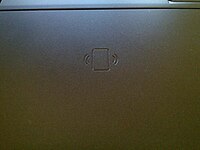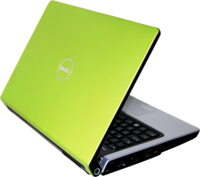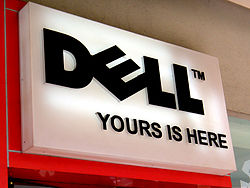
Dell Latitude is a laptop brand from Dell, targeted for business use. This means that standardized parts are used throughout the line and are available for several years for support purposes. By contrast, the Dell Inspiron is aimed at the consumer market and its specifications change regularly. Whereas Inspiron may change vendors on components several times over the course of a single model, the Latitude line generally retains identical components throughout its production. This design is intended to simplify maintenance and support tasks for large corporations, allowing components to be easily swapped between models.
Dell Latitude computers are also built to Dell's RoadReady specification which includes a durable magnesium-alloy casing (though D500/E5000-series Latitudes are mainly plastic), internal metal frames and Strike Zone shock protection in case the computer is dropped or suffers a severe impact. Many models also feature free-fall sensors or solid-state drives. Latitude models are also considered[weasel words] more durable and higher quality than the Inspiron line, and even above the premium Studio and XPS models. The Ultraportable 4-series and mainstream 6-series Latitude models have 3 year US-based support, as opposed to the 1 year warranty on other models. The essential Latitudes retain the 1 year warranty of other products.But, this results in a price several hundreds of dollars higher compared to the consumer models.
Latitude computers are also differentiated in their feature sets, due to their business focus. For example, they often include security features such as smartcard and contactless smartcard, and TPM security, which are not needed by most consumers. A lid clasp (as opposed to a magnetic latching system), DisplayPort video out (as opposed to HDMI), and support for legacy standards are all results of the requirements of the business market.
Some models also have the capability of Latitude ON which can be selected during the configuration of the laptop. Latitude ON is essentially a system within a system. It requires a separate add on module which contains its own microprocessor and Operating system. This allows the laptop to function in the realm of a Netbook.
The primary competitors to the Latitude series are the Lenovo Thinkpad line and the HP Elitebook line, both of which offer similar business oriented features and durability of the Latitude line.
Current models

As of 2011 Dell's Latitude shipments primarily involve the Latitude E-series, introduced in August 2008, on the Exx00 revision. All E-series models ending in "00" have the Intel Centrino 2 (Montevina) chipset, as well as some variation of the Intel Celeron or Intel Core 2 Duo processors. The mainstream models are separated into two categories: essential and standard. The essential models are the E54x0 and E55x0, while the standard models are the E64x0 and E65x0. The E64x0 and E65x0 generally use higher end materials like Tri-metal (magnesium alloy) for the chassis, while E5xx0 lines tend to have a plastic chassis (though the new E5420 and E5520 appear to feature Tri-metal casing ). The E6xx0 lines also generally offer higher-end features like dedicated graphics.
The Latitude series also include a number of specialty models. The E42x0 and E43x0 are ultra-portable notebooks. The Latitude E64x0 ATG is a ruggerdized version of the E64x0, and is Dell's only semi-rugged offering. Dell's fully-rigged offering, the XFR, has transitioned from the D to the E series. The Latitude XT2 is a touch-screen convertible-tablet computer. Other models like the 13 and the Z have been added to the line also.
Unlike previous models the E series does not have the ability for a second battery in the modular bay. Instead a large "battery slice" can be purchased. The battery slice with the same foot-print as the laptop uses the docking connector located on the bottom of the laptop to provide additional power. As a draw-back, the laptop can not be docked while the battery is in place and the battery requires a separate charger. However, with the inclusion of the extra battery, the overall run time for the E series is substantially greater when compared to other Latitude series computers.
- E6520: 15.6" Mainstream (Core i3/i5/i7)
- E6420: 14.0" Mainstream (Core i3/i5/i7)
- E6320: 13.3" Ultraportable (Core i3/i5/i7)
- E5520: 15.6" Essential (Core i3/i5/i7)
- E5420: 14.0" Essential (Core i3/i5/i7)
- E5520m: 15.6" Value (Core2Duo)
- E5420m: 14.0" Value (Core2Duo)
- E4310: 13.3" Ultraportable (Core i3/i5)
- E4200: 12.1" Ultraportable (Core2Duo ULV)
- 2120: 10.1" Rubberized Netbook (Atom N455/550)
- 13 13.3" Ultra-Thin and Light (Core2Duo)
- XT2: 12.1" Touch Tablet (Core2Duo ULV)
- XT2 XFR: 12.1" Touch Tablet Fully-Rugged (Core2Duo ULV)
- E6420 ATG: 14.1" Semi-Rugged (Core i5/i7)
- E6410 ATG: 14.1" Semi-Rugged (Core i5/i7)
- E6400 XFR: 14.1" Fully-Rugged (Core2Duo
Previous models
- E5400: 14.1" Essential (Core 2)
- E5410: 14.1" Essential (Core i3/i5/i7)
- E5500: 15.4" Essential (Core 2)
- E5510: 15.6" Essential (Core i3/i5/i7)
- E6400: 14.1" Mainstream (Core 2)
- E6410: 14.1" Mainstream (Core i3/i5/i7)
- E6500: 15.4" Mainstream (Core 2)
- E6510: 15.6" Mainstream (Core i3/i5/i7)
- E4300: 13.3" Ultraportable
- E4310: 13.3" Ultraportable (Core i5)
- E6400 ATG: 14.1" Semi-Rugged (Core 2)
- 2100 10.1" Netbook
- 2110 10.1" Netbook
- Z 16.0" Thin and Light
The previous series is the Latitude D-series, on the Dx30 revision. The models are the D4x0 (12.1" Ultra Mobile), D5x0 (15,4" AMD Processor Value model), D6x0 (14.1" Corporate model) and D8x0 (15.4" high-resolution model) most models are based on the Intel Core 2 Duo and the Intel Santa Rosa chipset, with the exception being the D531. Ever since the D420, D620, and D820, the D-series features wide aspect LCD screens: 12.1", 14.1", and 15.4" respectively.
The Latitude D620 weighs 4.7 lb, and the base model includes a 1.67 GHz Intel Core Duo T2300 processor (667 MHz front-side-bus) and 2 MB (2
MiB) of L2 cache. There is an option to upgrade to a Core 2 Duo T7X00 processor (667 MHz front-side-bus) with 4 MB of L2 cache. It comes standard with 512 MB of DDR2 RAM, expandable to 4
GB (4
GiB), and four USB ports. For graphics, it offers the Intel Graphics Media Accelerator x3100, and an option to upgrade to NVIDIA discrete graphics at the expense of lower battery life.
Latitude D6x0 series
The Latitude D6x0 series is the 14"/14.1" corporate model. It aims to combine heavy-duty power with reasonable portability, and differs primarily from D8x0 series in screen size. All are two spindle designs, with a "D-bay" modular bay which can interchange optical drives, a second hard drive, floppy disk or a second battery. All models have a smart card socket, PCMCIA socket, and 9-pin serial port, a "D-dock" port for docking station or port replicator, and have an internal socket for a 802.11 wireless card.
The D600 and D610 share a common form factor, battery socket, and have a parallel printer port.
The D620 and D630 share a common form factor, battery socket, and do not have a parallel printer port. Both have support for an optional internal Bluetooth module, a socket for an optional mobile broadband card, and have an external switch for disabling any wireless connections.
Latitude D600
The D600 (and simultaneously-introduced D800) was Dell's first business-oriented notebook based on the Pentium-M processor; it used the first-generation "Banias" or Dothan Pentium M chips running on a 400 MT/s FSB on DDR memory. It had a PATA hard drive and a D-series modular bay, and used an ATI GPU Radeon 9000. It had a 14" screen, in regular (non-widescreen) form factor. Unlike later D6x0 series machines, both memory sockets were accessible from a single cover on the bottom of the system.
Many Latitude models had a near-clone Inspiron, in the case of the D600, it was the Inspiron 600M. Differences include that the 600M does not work with the Dell D-Dock, and the case styling is slightly different. The motherboards, screens and hard drive caddies are all physically interchangeable.
Latitude D610
The D610 was an update of the D600 design; it used the same case design and very similar specs. The chipset was updated (to the "Sonoma" platform) and used DDR2 memory, and it used a second-generation "Dothan" Pentium M chips running on a 533 MT/s FSB (and available in higher speeds.) The location of one memory socket was moved to underneath the keyboard. The D610 was available with either an ATI Mobility Radeon X300 discrete GPU or Intel integrated graphics. It still continued to use a PATA hard drive and D-series modular bay.
Many Latitude models had a near-clone Inspiron, in the case of the D610, it was the Inspiron 610M.
Latitude D610 problems
Some Dell Latitude D610 units with a dedicated ATI x300 graphics card seem to have problems with the audio-out jack. Symptoms of this problem include a noise or whine when an audio device is connected to the audio-out jack. Up to this date Dell does not have a clear solution to this problem.
A number of Dell Latitude D610 units will develop microscopic fractures of the motherboard. Symptoms of this problem may include inability to turn on the computer, unexpected shut down within 30 seconds of being turned on, or visible screen artifacts while in operation. This problem also frequently contributes to the
blue screen of death (BSOD) in Windows.
Latitude D620
The D620 (and simultaneously-introduced D820) was Dell's first business-oriented notebook with a dual core processor available. Initially available with the interim "
Yonah" Core Duo processors, it was sold with the first-generation mobile "
Merom" Core 2 chips once those became available from Intel in the Fall of 2006; both run on a 667MT/s bus. It was initial sold only with Intel integrated graphics, but an option to upgrade to a discrete NVidia GPU became available after a few months. It replaced the raised pointing stick with a "low profile" model, and introduced the option of 4-cell and 9-cell batteries in addition to the standard 6-cell model. It uses DDR2 memory and is compatible with both PC2-4200 (533 MHz) and PC2-5300 (667 MHz) memory.
Although the D620 is capable of accepting 4 GB of physical memory, but because of the limitation by the BIOS of a notebook (and not because the user is using 32bit or 64bit OS), it will only see 3.5 GB of memory, or 3.3 with on board video (memory is shared). Using 64-bit OS will not help user to see all 4 GB of RAM on D620.
[citation needed]
The D620 has one mono speaker located in the base below the touchpad. It has no option to expand to stereo without using external speakers or headphones.
There was no near-clone Inspiron model for the D620.
[edit] Latitude D620 problems
All early D620 models were known for faulty LCD screens. All of these early models suffered from light bleeding, where a black screen would show light bleeding in from the bottom of the screen. This wasn't fixed until almost a year into production. In addition, some D630 screens are known for having bad LCD pixels. The D620 and D630 were available with a Intel Media Accelerator 950 or a NVidia Quadro NVS 110M Graphics Card (64 or 128 MB memory). All vidia models will suffer from early failure of the graphics chip due to the cold-hot cycle and varying thermal expansion. This is attributed to a faulty manufacturing on part of Nvidia which caused a multimillion recall not only of some Dell notebooks but also some HP, Compaq and Apple products
Affected models. The failure manifests itself by stripes or bizarre patterns on the LCD AND also an external screen or by the total absence of an image. There is no permanent fix for it and the early replacements by dell included only the same but new faulty chips which will also fail eventually. So far only the models with the Intel Graphics seem to have survived. Dell tried to prolong the lifetime of the nvidia chips with a bios update which causes the fan to run more continuasly and thus reduce the strain from hot to cold and vice versa cycles of the graphics chip. However all these chips will die eventually.
Latitude D630
The D630 is an update of the D620 design. It differed most significantly in being based on the "Santa Rosa" (mobile 965) chipset, which supported the 800MT/s models of the mobile Core 2 Duo (both the Merom 7xx0 series and later the Penryn-based 8x00/9x00 series.) It also had newer versions of the graphics processor options, support for Intel's "Turbo Memory" flash cache (although this uses the same card slot as the mobile broadband card), and support for internal Wireless-N. It also added a 4-pin Firewire
IEEE1394 port. It uses DDR2 memory and is compatible with PC2-5300 (667 MHz) and PC2-6400 (800 MHz) memory will work, but at PC2-5300 speeds.
Unlike the D620, the D630 has stereo speakers.
There was no near-clone Inspiron model for the D630.
Latitude D630c
The D630c was a slight variant model of the D630; it featured a "manageable" version of the motherboard chipset, and base configuration was slightly more powerful. Except for the chipset management, all of those "base features" were available as options on the regular D630.
Latitude D8x0 series
The Latitude D8x0 series is the 15.4" corporate model; unlike the D6x0 series, all feature a widescreen form factor. All are two spindle designs, with a "D-bay" modular bay which can interchange optical drives,a floppy module, a second hard drive, or a second battery. All models have a smart card socket, PCMCIA socket, and 9-pin serial port, a "D-dock" port for docking station or port replicator, and have an internal socket for a 802.11 wireless card.
The D800 was Dell's first widescreen Latitude
The D8x0 series models roughly parallel the technology in the D6x0 models, other than for screen size; they do not share a battery form factor with the D6x0 series. The D820 and D830 add an ExpressCard socket, not available in the D6x0 series. Although the D820 is capable of accepting 4 GB of physical memory, because of Intel 945 chipset limitations, it makes at most 3.5 GB of memory available to the installed operating system.
The near-clone Inspirons for the D800 and D810 were the Inspiron 8500 and 8600; there were no near-clones of the D820/D830.
Latitude D5x0 series
The Latitude D500 series is a set of "entry level" business models; they are built on a 15" non-widescreen form factor, although models before the D530 were sold with both 14.1" and 15" screens (the 14.1" having a wider bezel.) They are fixed-optical-drive, 2-spindle devices, and roughly follow the technical generations (chipset and processor-wise) of the D6x0 and D8x0 series. The D530 was Dell's last non-widescreen Latitude model.
The D531 was an AMD-based model, and less closely related to the other Dx30-series models.
Latitude D4x0 series
The D400 and D410 were 12" non-widescreen (4:3 aspect ratio) ultra-portable notebooks, roughly following the technology of the comparable generations of the series. The D400 came with a ULV Pentium M (Banias). The D410 came with a ULV Pentium M (Dothan).
The D420 and D430 are 12.1" widescreen ultra-portable notebooks. The D420 came with either an [Intel Core] Solo U1300 ULV 1.06 GHz or [Intel Core] Duo U2500 ULV 1.2 GHz. The D430 came with either an Intel Core Solo U1400 ULV 1.2 GHz or Intel Core 2 Duo U7600 1.2 GHz; the U7700 Processor (1.33 GHz) was later made available as an option.
While the D8x0, D6x0 and D5x0 models were all introduced simultaneously with each generation, the D4x0 series were generally introduced a couple of months after their counterparts. Also, since they use ULV (ultra-low-voltage) processors and chipsets, and are generally less powerful, the technology does not correspond as closely as it does between other models in each generation - for example, the D420 uses the parallel ATA hard drive (1.8") rather than the SATA (2.5") interface in the D520/620/820.
In a 22C deg ambient the D430 U7700 processor has been measured to run from 62C deg at idle to 85C deg under heavy system loads, that is, within 10C deg of Intel's max. temperature rating for the processor. The D4x0 series has been replaced by the E4200 model.










